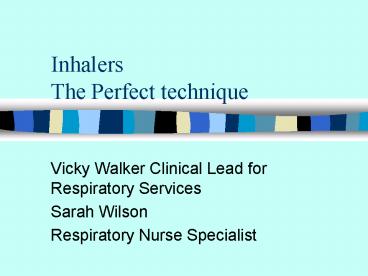Inhalers The Perfect technique - PowerPoint PPT Presentation
1 / 23
Title:
Inhalers The Perfect technique
Description:
Practical demonstrations of common inhalers, through DVD and audience ... is removed the inhaler is primed and ... a good upright position to use inhaler ... – PowerPoint PPT presentation
Number of Views:2317
Avg rating:4.0/5.0
Title: Inhalers The Perfect technique
1
InhalersThe Perfect technique
- Vicky Walker Clinical Lead for Respiratory
Services - Sarah Wilson
- Respiratory Nurse Specialist
2
Which inhaler is right for your patient?
3
Contents
- Quiz - test your current knowledge
- Information on devices
- Practical demonstrations of common inhalers,
through DVD and audience participation (thats
you!) - case studies
- Our role - how we can help?
- What to do next.
4
Aims of the teaching
- Update and increase knowledge on different
devices - Test baseline knowledge ( to improve at the end
of the session!) - To become more familiar with delivery devices
- Increase skills in assessment of technique
- How to trouble shoot
5
Quiz time
6
Metered dose inhalers (MDI)
- Cheap, Quick convenient to use
- Poor inhaler technique is common
- When used correctly only 10-20 of the drug
reaches the lungs - may continue to deliver propellant after active
drug gone if not shaken correctly - important to wait 30-60 secs between doses due to
2nd actuation being of poorer quality
7
Breathe actuated inhalers
- Spring mechanism is triggered by inspiratory flow
rate of 22-36 l/m - drug delivery less dependent on technique
- When cap is removed the inhaler is primed and
ready to fire - Ref AJ Corlett 1996 Caring for Older People
Aids to compliance with medication BMJ
1996313926-929 12 October
8
Spacer devices
- Removes the need for co-ordination of breathing
and actuation - Pharyngeal deposition is greatly reduced
- smaller particles penetrate further into lungs
depositing a greater proportion of drug - Available with mask
- Electrostatic charge reduces delivery
9
Dry Powder inhalers (DPI)
- Inspiratory airflow releases the fine powder -
therefore no co-ordination needed - dose counters helps patients to know when empty
(between 60-200 doses) - DPI can make some patients cough
- Inspiratory flow rate needed may be a problem
with some devices
10
Dry Powder inhalers (DPI) continued
- More expensive than MDIs
- DPIs such as turbohalers have no taste, hence
there could be uncertainty it has been taken by
the patient - Turbohalers delivers 20-30 of drug
- Diskhaler delivers 11-15 of drug
- RefOptimizing deposition of aerosolizesd drug in
the lung
11
Important points
- Patient needs to be in a good upright position to
use inhaler - Important to check inhaler technique regularly
- Bad habits form quickly
- If a patient is requiring repeat prescriptions
alarm bells should be ringing
12
DVD Inhaler demonstration
13
Case Study 1
- 73 year old lady with severe COPD
- referred for Pulmonary Rehabilitation
- probable low inspiratory breath
- using Turbohalers but struggling
- Tested with Turbotrainer whistle
- Switched to MDI and Volumatic spacer
- beautiful technique with tidal breathing
14
Case Study 2
- 88 year old with moderate COPD
- Using MDI aerochamber
- Struggling to fire inhaler consistently
- Tried on turbohaler trainer whistle
- Successful with whistle
- Switched to turbohaler
- Reviewed by CSW 1 month later managing well, with
good benefit
15
Case Study 3
- Bingo dobber V turbohaler
16
The Good, The Bad and The Ugly
17
The Bad
- Allergy to the cat
- Down the nose
- Christmas present
- Current prescription
- Blowing
- Upside down
- Huff and puff
- If at first..
18
- Mrs Smith has moderate COPD the GP asks for your
advice on combination therapy. - Which device would you recommend?
19
Trick question ?
20
How we can help patients?
Refer to the respiratory team if commenced on
oxygen
Do they need a portable/ambulatory cylinder
A name for your chest problem
Early discharge scheme from LTHT
Telehealth in the patients home
Home visits
Perform spirometry in patients home
What to do when ill
Telephone support and advice
Home exercise programme for patients
Advice on smoking cessation
Inhaler technique check
Refer to our Pulmonary Rehabilitation programme
Patients can self refer to the Respiratory Team
21
(No Transcript)
22
What to do next?
- If you are still struggling with a tricky or
complex patient then please refer on to your
local Respiratory Team - contact details
- East Wedge 2953499
- South Wedge 2954641
- West Wedge 3059293 (west, north west north
east)
23
Which inhaler is right for your patient?The one
they can use.































